#too light too dark
Explore tagged Tumblr posts
Text
More on pre-electricity lighting.
Interesting to see this one pop up again after nearly two years - courtesy of @dduane, too! :->
*****
After experiencing a couple more storm-related power cuts since my original post, as well as a couple of after-dark garden BBQs, I've come to the conclusion that C.J. Cherryh puts far too much emphasis on "how dark things were pre-electric light".
For one thing eyes adjust, dilating in dim light to gather whatever illumination is available. Okay, if there's none, there's none - but if there's some, human eyes can make use of it, some better or just faster than others. They're the ones with "good night vision".
Think, for instance, of how little you can see of your unlit bedroom just after you've turned off the lights, and how much more of it you can see if you wake up a couple of hours later.
There's also that business of feeling your way around, risking breaking your neck etc. People get used to their surroundings and, after a while, can feel their way around a familiar location even in total darkness with a fair amount of confidence.
Problems arise when Things Aren't Where They Should Be (or when New Things Arrive) and is when most trips, stumbles, hacked shins and stubbed toes happen, but usually - Lego bricks and upturned UK plugs aside - non-light domestic navigation is incident-free.
*****
Here are a couple of pics from one of those BBQs: one candle and a firepit early on, then the candle, firepit and an oil lamp much later, all much more obvious than DD's iPad screen.

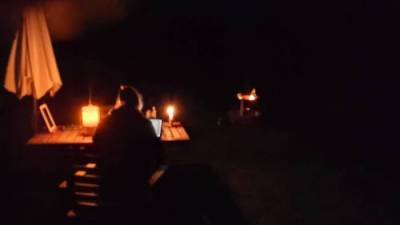
Though I remain surprised at how well my phonecam was handling this low light, my own unassisted eyes were doing far better. For instance, that area between the table and the firepit wasn't such an impenetrable pool of darkness as it appears in the photo.
I see (hah!) no reason why those same Accustomed Eyes would have any more difficulty with candles or oil lamps as interior lighting, even without the mirrors or reflectors in my previous post.
With those, and with white interior walls, things would be even brighter. There's a reason why so many reconstructed period buildings in Folk Museums etc. are (authentically) whitewashed not just outside but inside as well. It was cheap, had disinfectant qualities, and was a reflective surface. Win, win and win.
*****
All right, there were no switches to turn on a light. But there was no need for what C.J. describes as stumbling about to reach the fire, because there were tinderboxes and, for many centuries before them, flint and steel. Since "firesteels" have been heraldic charges since the 1100s, the actual tool must have been in use for even longer.
Tinderboxes were fire-starter sets with flint, steel and "tinder" all packed into (surprise!) a box. The tinder was easily lit ignition material, often "charcloth", fabric baked in an airtight jar or tin which would now start to glow just from a spark.
They're mentioned in both "The Hobbit" and "The Lord of the Rings". Oddly enough, "Hobbit" mentions matches in a couple of places, but I suspect that's a carry-over from when it was just a children's story, not part of the main Legendarium.
Tinderboxes could be simple, just a basic flint-and-steel kit with some tinder for the sparks to fall on...

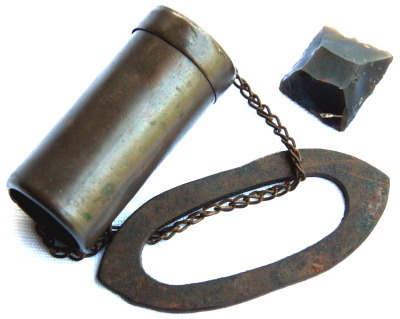
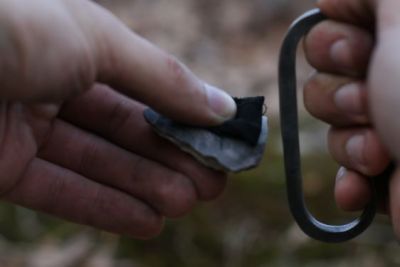
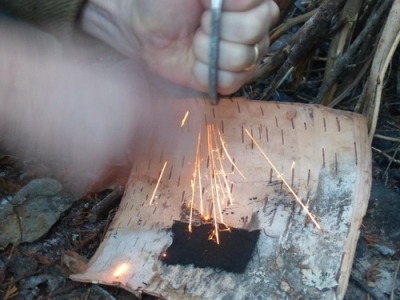
...or elaborate like this one, with a fancy striker, charcloth, kindling material and even wooden "spills" (long splinters) to transfer flame to a candle or the kindling...
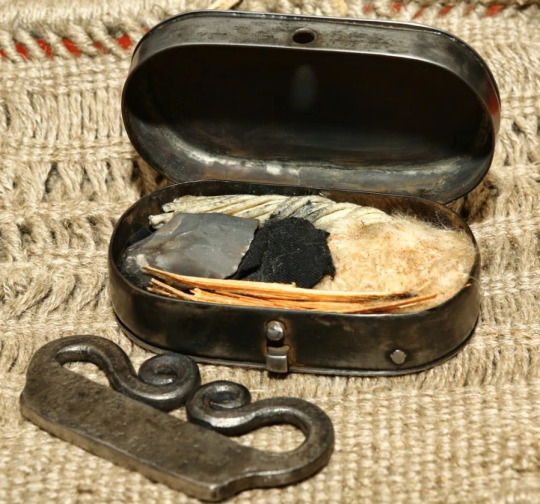
This tinderbox even doubles as a candlestick, complete with a snuffer which would have been inside along with everything else.

Here's a close-up of the striker box with its inner and outer lids open:

What looks like a short pencil with an eraser is actually the striker. A bit of tinder or charcloth would have been pulled through that small hole in the outer lid, which was then closed.
There was a rough steel surface on the lid, and the striker was scraped along it, like so:

This was done for a TV show or film, so the tinder was probably made more flammable with, possibly, lighter fuel. That would be thoroughly appropriate, since a Zippo or similar lighter works on exactly the same principle.
A real-life version of any tinderbox would usually just produce glowing embers needing blown on to make a flame, which is shown sometimes in movies - especially as a will-it-light-or-won't-it? tension build - but is usually a bit slow and non-visual for screen work.
*****
There were even flintlock tinderboxes which worked with the same mechanism as those on firearms. Here's a pocket version:
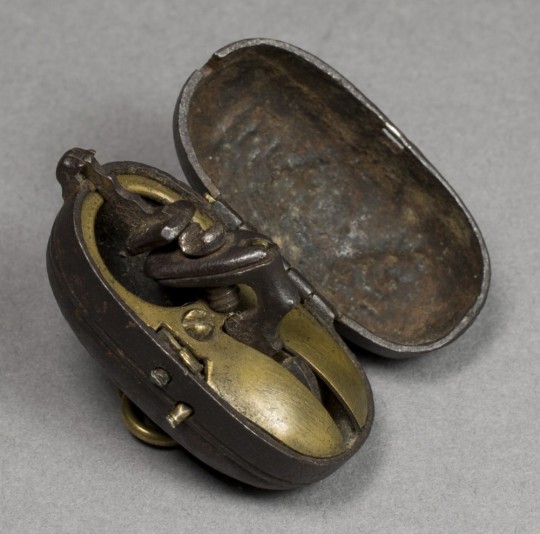
Here are a couple of bedside versions, once again complete with a candlestick:
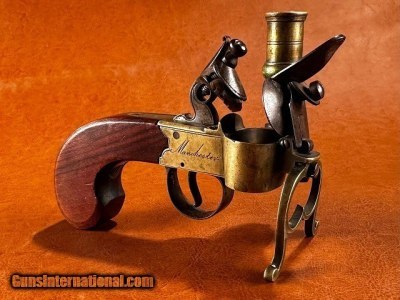
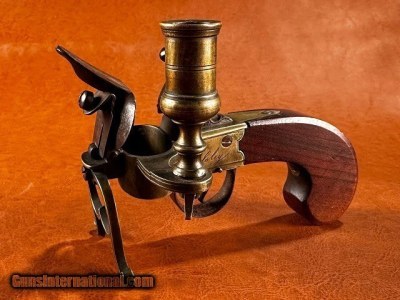
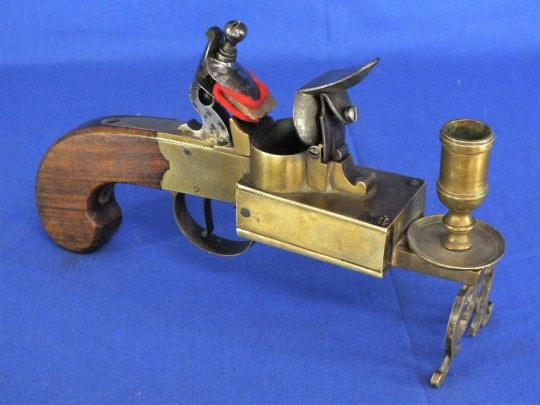
And here are three (for home defence?) with a spotlight candle lantern on one side and a double-trigger pistol on the other.

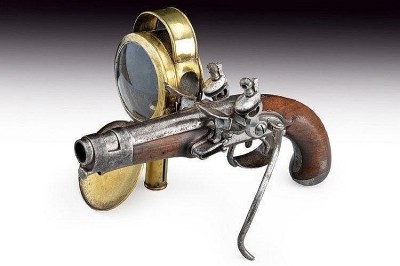
Pull one trigger to light the candle, pull the other trigger to fire the gun.

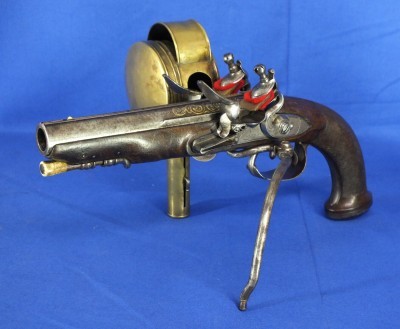
What could possibly go wrong? :-P
*****
Those pistol lanterns, magnified by lenses, weren't just to let their owner see what they were shooting at: they would also have dazzled whatever miscreant was sneaking around in the dark, irises dilated to make best use of available glimmer.
Swordsmen both good and bad knew this trick too, and various fight manuals taught how to manage a thumb-shuttered lamp encountered suddenly in a dark alley.
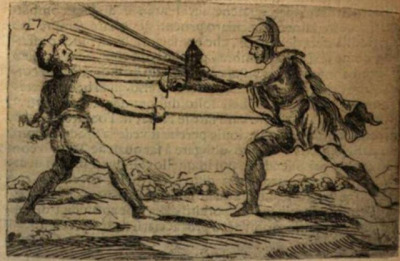
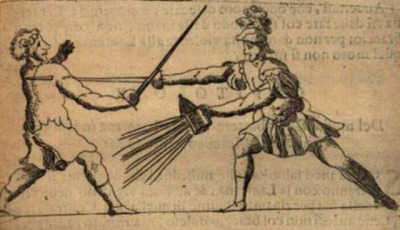
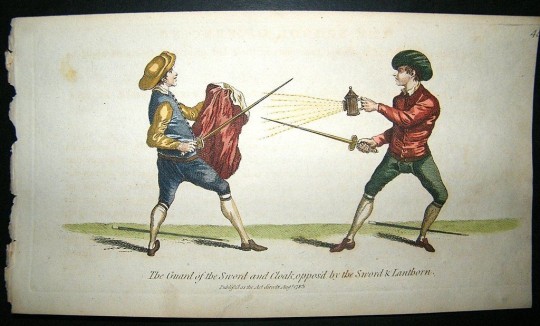
There's a sword-and-lantern combat in the 1973 "Three Musketeers" between Michael York (D'Artagnan) and Christopher Lee (Rochefort), which was a great idea.
Unfortunately it failed in execution because the "Hollywood Darkness" which let viewers see the action, wasn't dark enough to emphasise the hazards / advantages of snapping the lamps open and shut.
This TV screencap (can't get a better one, the DVD won't run in a computer drive) shows what I mean.
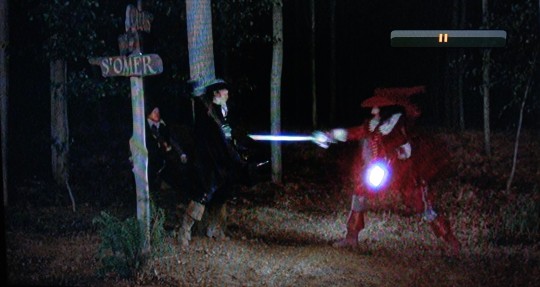
In fact, like the photos of the BBQ, this image - and entire fight - looks even brighter through "real eyes" than with the phonecam. Just as there can be too much dark in a night scene, there can also be too much light.
*****
One last thing I found when assembling pics for the post were Folding Candle-lanterns.
They were used from about the mid-1700s to the later 20th century (Swiss Army ca. 1978) as travel accessories and emergency equipment, and IMO - I've Made A Note - they'd fit right into a fantasy world whose tech level was able to make them.
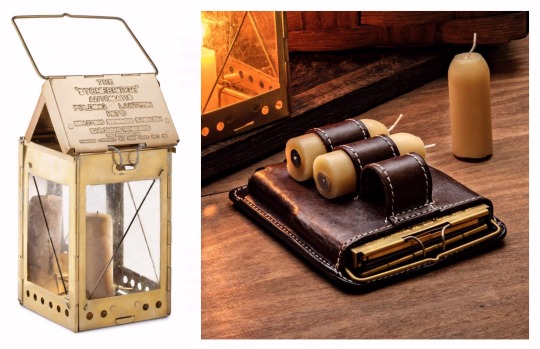
The first and last are reproductions: this one is real, from about 1830.
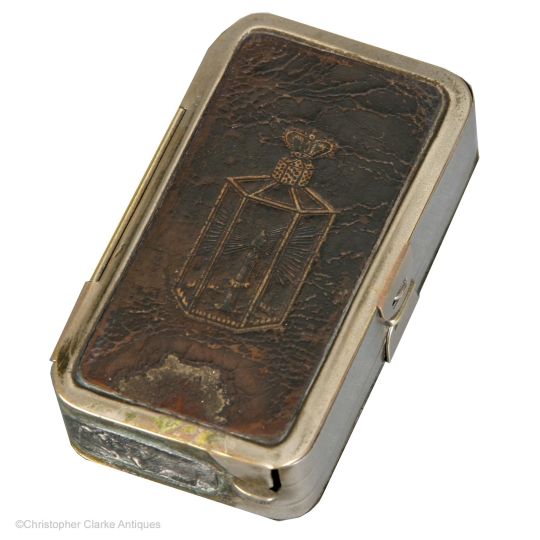
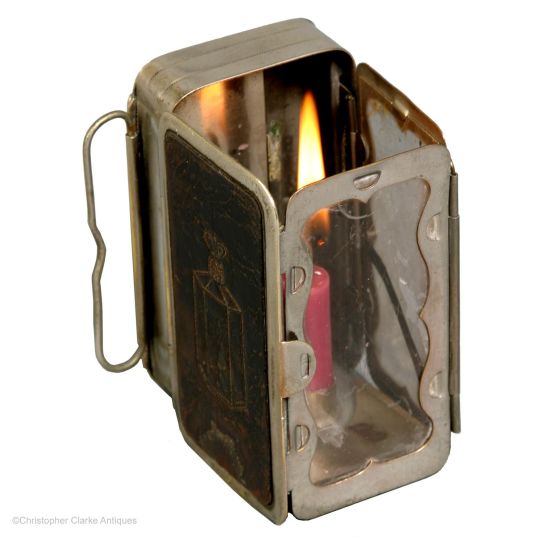
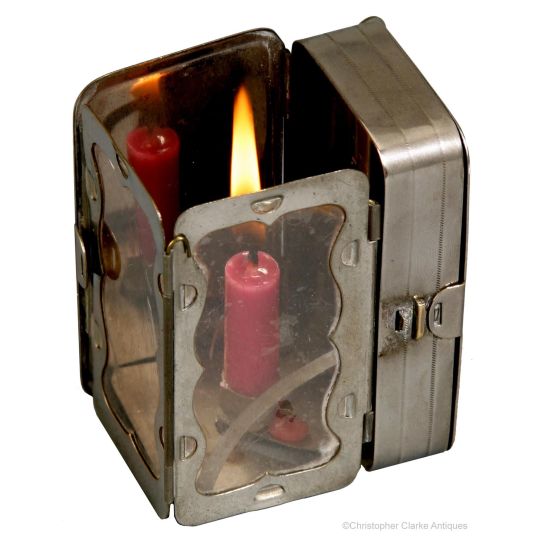
The clear part was mica - a transparent mineral which can be split into thin flexible sheets - while others use horn / parchment, though both of these are translucent rather than transparent. Regardless, all were far less likely to break than glass.
One or two inner surfaces were usually tin, giving the lantern its own built-in reflector, and tech-level-wise, tin as a shiny or decorative finish has been used since Roman times.
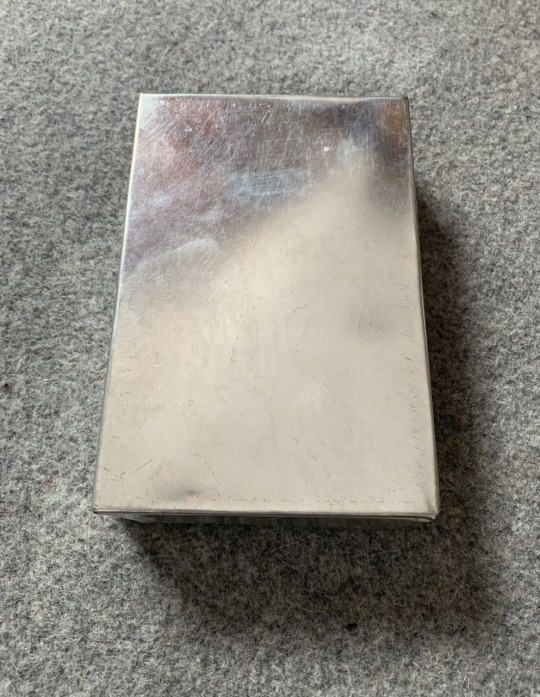

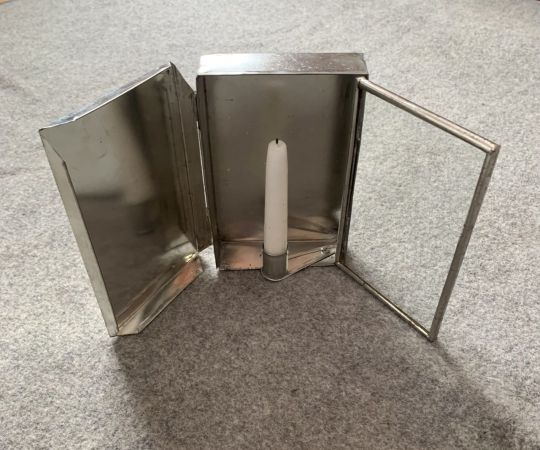

I'm pretty sure that top-of-the-line models could also have been finished with their own matching, maybe even built-in, tinderboxes.
And if real ones didn't, fictional ones certainly could. :->
*****
Yet more period lighting stuff here, including flintlock alarm clocks (!)
#period lighting#tinderbox#too light too dark#social history#writer notes#research#period tech#sword vs lantern#c. j. cherryh
2K notes
·
View notes
Text

– Noor Unnahar, Instagram account "noor_unnahar"
[TEXT ID: / [Lemons] / My father's mother loved lemons. Years after her passing, / we run out of everything, but never / lemons. / Nothing else shelters grief / better than memory. / It's my father way of saying, / even in your absence, you will be / cared by me. / END ID]
#reminds me of my mom who now watch english movies even though english is not her first language and struggles to understands too but she do#all this because of my brother who loved to watch different movies while growing up but now move to another countryy#so she remembers him while watching that#now we all should cry together#light academia#dark academia#excerpts#fragments#poetry#words#literature#noor unnahar#spilled poem#short peoms#grief poem#grief#on grief#spilled thoughts#peots on tumblr#spilled ink
19K notes
·
View notes
Note
What if Monster High Danny met Bunny Danny?
Itd be some spiderverse type shit tbh
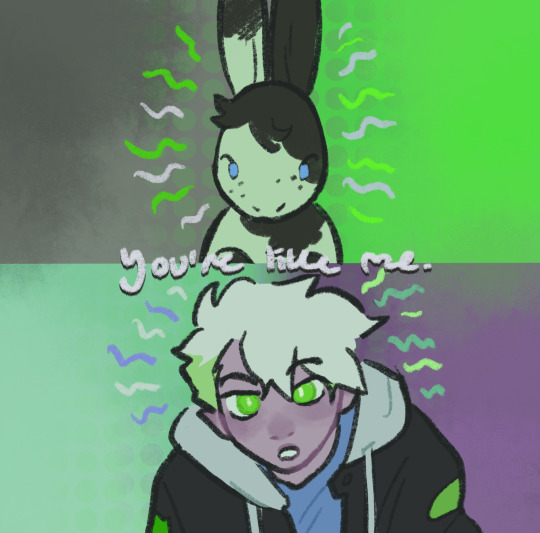
#idk why it turned out so dark#guess the light on my screen was too bright while drawing oops lol#danny phantom#my art#half normie au#bunny au
2K notes
·
View notes
Text
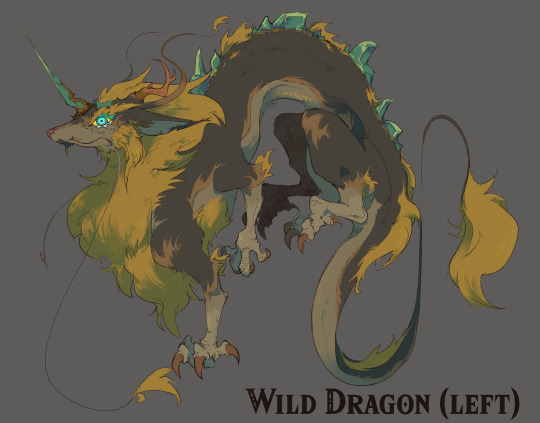
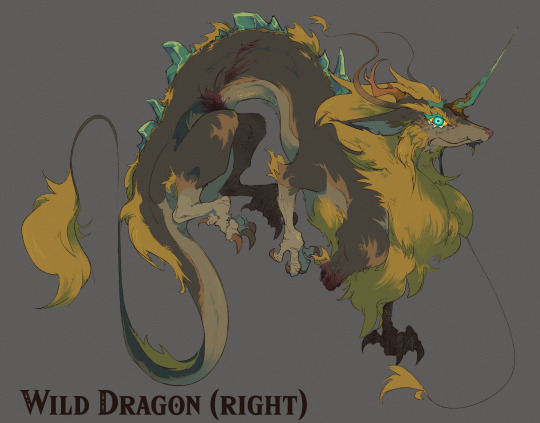
(click for higher quality!) draconified link concept ive been chipping away at this past week ..... here's my funny little compendium concept for him:
"A heroic spirit has taken the form of this bestial dragon. Unlike it's kin, this creature exhibits an extremely aggressive disposition. It appears highly territorial, and will relentlessly chase down those who disturb its skywide patrols - of which it seems to be endlessly searching for either a long-time vassal or foe. Unfortunately, it seems the spirit within has long since forgotten exactly who it was looking for…"
#now. how on earth do i begin to tag this. um.#link#loz#totk#totk spoilers#light dragon#dragon link#loz au#totk roleswap au#there . i'll add more if they come to me LOL#um i can talk about some of my insps i guess?? might make another post too#so mostly i just dont really like turning him into 'light dragon but male' and giving him slightly darker colours or something like that#this also obviously isnt exactly like the botw dragons either though and its a bit more of a mix of other creature concepts i enjoy#since everyone agrees he'd have a farosh horn i wanted to make him a kirin/unicorn :) which is why his tail looks like that#aside from the obvious eastern dragon insps and what ive picked and chosen from the botw dragons#and obviously this looks a lot like wolf link. thats on purpose#i wanted to give him some fierce deity design refs too but because this is so dark/earthy they didnt look very fitting#but honestly you could do a whole fierce deity dragon design on its own i think#okay lots of tags but IVE THOUGHT ABOUT THIS FOR A WHILE. okay. let me have this.#my art#dragon link au
5K notes
·
View notes
Text


realized that both the beginning and the end of the happy paris stage of Loumand's relationship has this same contrasting orange to blue/green color scheme. and like. the visual metaphor of Armand literally leaving his cold, lifeless world behind him and choosing the bright, golden warmth of life with Louis instead of killing him like he was supposed to in that tunnel. but as soon as he chooses the coven over Louis, he separates from the warmth like oil in water that was never supposed to be there. and now he's back out in the cold. I'm normal about this, btw.
#armand's look in the restaurant scene is going to haunt me foreverrrr too#he just found out louis genuinely does care for him and even started to move on but the play is literally already written and rehearsed#anyways...I love cinematography#yellowjackets does a lot with orange vs blue too it's become a favorite coloring trope of mine#it's visually more fun than just light vs dark and works well for horror too#iwtv#iwtv parallels#iwtv season 2#iwtv spoilers#interview with the vampire#armand#louis de pointe du lac#loumand#iwtv meta#.txt#🐌🏳️🌈
3K notes
·
View notes
Text





BANG CHAN ♡ GIANT MV
#stray kids#bang chan#bystay#staysource#channiesnet#createskz#staydaily#skzco#usersa#staytay#dreamytag#userbeepls#usertsu#usersemily#bitsforkitts#melontrack#*mine#flashing tw#please do not perceive the dithering too much. it was either lighting up to see him or leaving him in the dark for the sake of good quality#i'm crying in one of my screens they look okay-ish and in the other they look awful lmfao#anyway goodbye video i shall never gif you anymore
1K notes
·
View notes
Text





monster hunter stickers/prints.... take ur fave wretched animal and make them small and on your wall
#did xu wu first and was like mann i put way too much effort into that. i should relax with the others. i didnt#art#these guys and the fated four are some of my favourite monsters ever#you have like one or two normal-shaped dragon with a unique characteristics and then some freaks#wilds has majority ugly freaks and its so so good i love ugly creature design#monster hunter#mh#mh wilds#monster hunter wilds#monhun#rey dau#uth duna#nu udra#jin dahaad#xu wu#mh fanart#even drawing these mfs feel like hunts i have to scour for good reference pics and comprehend their patterns and all of them fight in#dark areas with coloured lighting which makes figuring our their base colours much harder
520 notes
·
View notes
Text
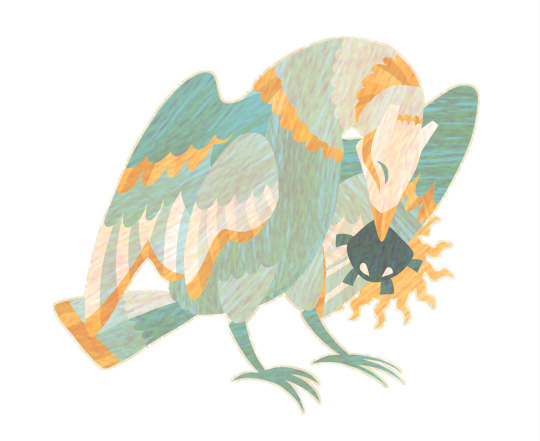

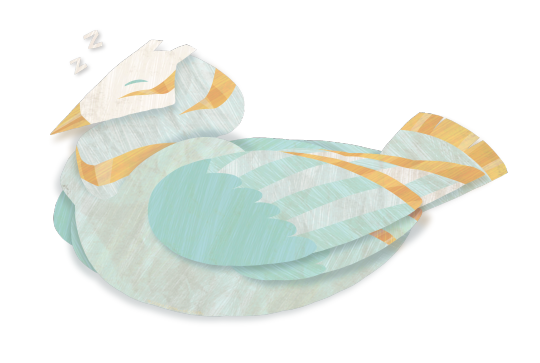
experimenting 🕊️
#yes these are based loosely on the style of that one “little caterpillar” book#and the authors style#i dont think i honed it down too well but i like trying it out#its very fun and pretty..#ive been drawing hymns alot lately#they are my muse..#and so cutes#i like to think younger hymns like to bother crabs and small dark creatures#kinda like seagulls in a way#hymns are like seagulls and pigeons combined#silly ass birds🫶#sky children of the light#sky cotl#sky: cotl#sky:cotl#skycotl#sky#sky: children of the light#speculative biology#spec bio
707 notes
·
View notes
Text

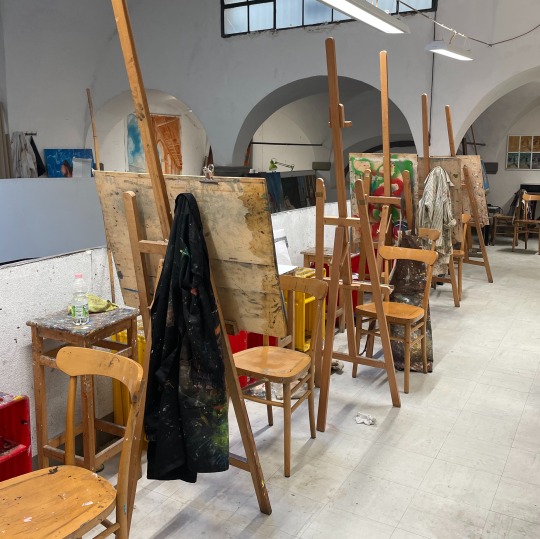
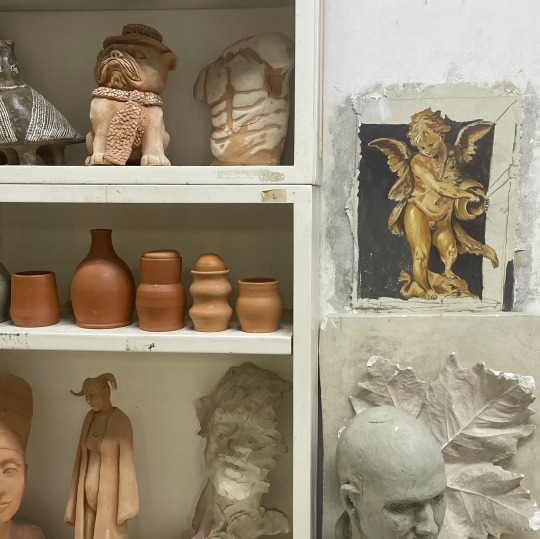

missing my tranquil walk home from the art school
#Praaaaying that my bf’s phd supervisor sends him back to Florence sometime soon (so that I could go with him and take fresco classes too 😊)#studyblr#light academia#studyspo#dark academia#bookblr#romantic academia#Traditional art#artblr#artists of tumblr#aesthetic vibes#Florence#Italy#firenze#toscana
3K notes
·
View notes
Note
Recent article on NPR about the history of artificial light somewhat frustrated me -- they portrayed all of pre-kerosene history as dark and heinously expensive at all times. Thing is, the writers based their findings solely on tallow candles, & ignored oil lamps, beeswax candles, clever use of refraction & outdoor light including moon/starlight... Also seemed to ignore the ubiquity of hearths / cook fires. Was wondering if you'd be willing to talk about non-tallow light? This isn't to ignore that truly, artificial lighting WAS much more difficult & expensive for much of human history, but acting like tallow candles were the ONLY light source seems very silly! (Plus your other lovely post about bottles of water used to make those candles more efficient via refraction & focus)
I'm betting the article you mean is this one - which refers back to this one.
For matching reference, my own posts about period lighting are here, One and Two, including observations about painting walls white, how to light candles and lamps without matches, and several other matters.
*****
It didn't take too much listening before I got tetchy, because the first half of this podcast seems more about mocking how WEIRD and PRIMITIVE old-time people were, than passing on any useful information.
Despite the presence of Jane Brox (author of "Brilliant: The Evolution of Artificial Light") whale oil only gets touched on in passing, and olive oil isn't mentioned at all.
Instead she starts talking about using oily seabirds (stormy petrels) as "candles", despite this scholarly study concluding that it was something talked about far more than done, besides being so very, very localised that its relevance to the history of lighting is very, very small.
But hey, WEIRD and PRIMITIVE, right?
*****
By contrast, making candles was so commonplace that it was another of those jobs which created surnames. Fletcher once put feathers on arrows, Cooper made barrels, Fisher, Miller, Baker and Farmer are obvious, and Chandler used to make candles.
Lampier, of course, made lamps, which helped keep those naked candle-flames away from anywhere they shouldn't touch. The man on the left is making the lantern bodies, the one on the right is shaving sheets of horn as windows.
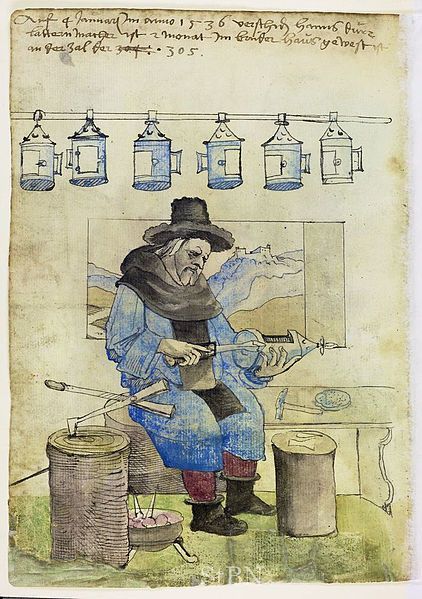
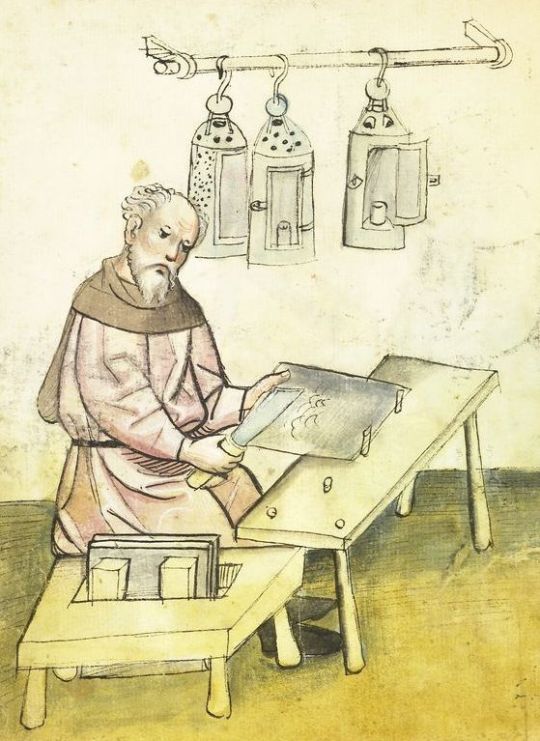
It's cheaper than glass, less easily broken yet is translucent enough, when shaved properly thin, to give quite adequate light.
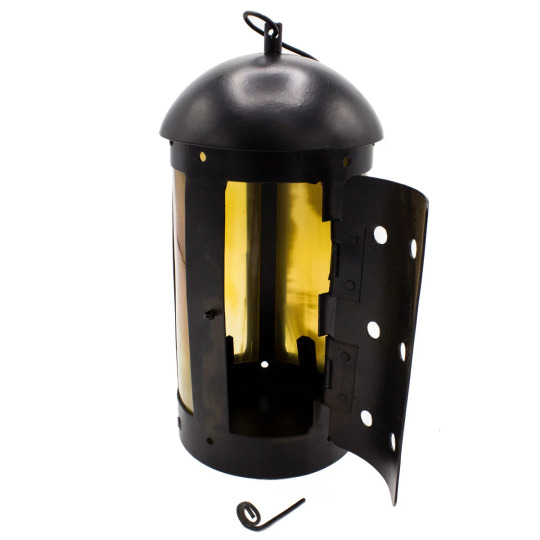
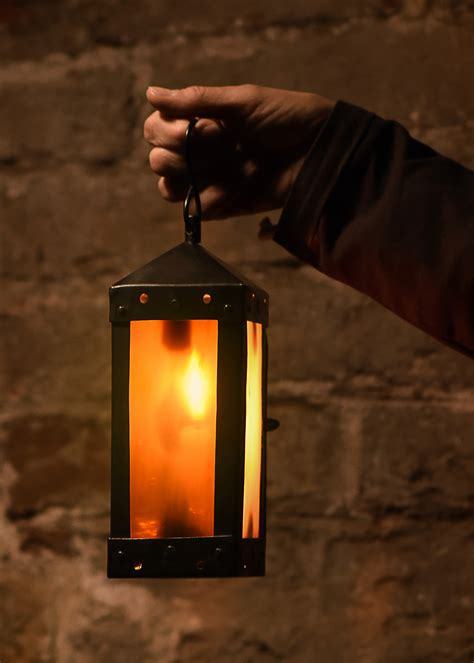
*****
The podcast has a digression about measuring the light output of a reproduction Ancient Babylonian lamp. Here's an original and a repro.
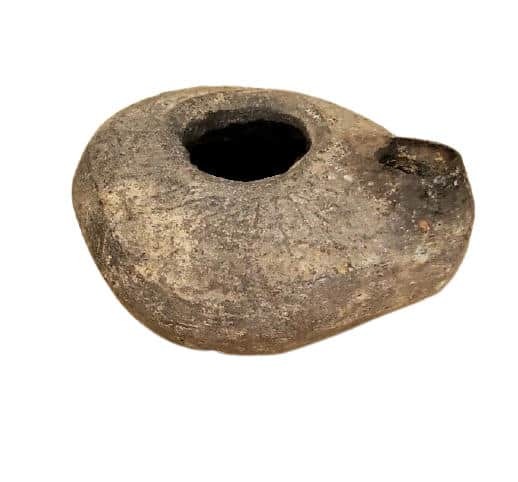
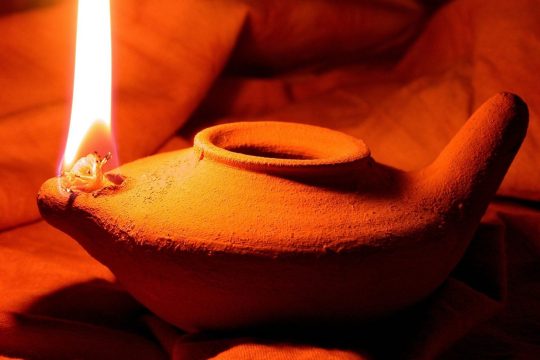
Yet that too says nothing about what fuel the lamp is or should be burning - olive oil, traded all over the Mediterranean by ancient olive-growing cultures.
These are Roman oil-lamps, from simple and cheap to elaborate and costly.

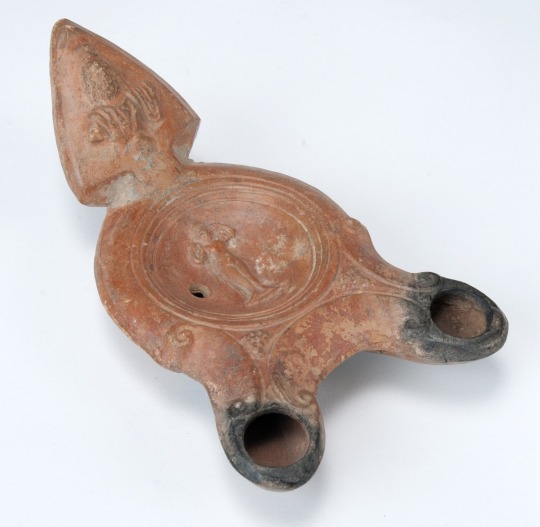
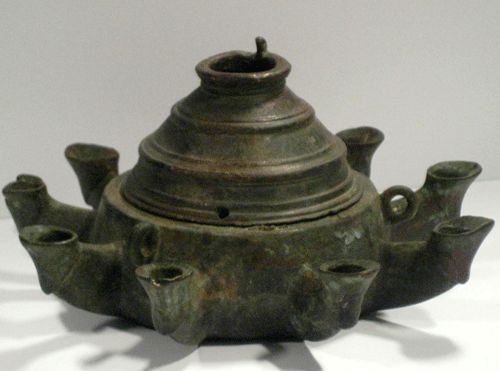
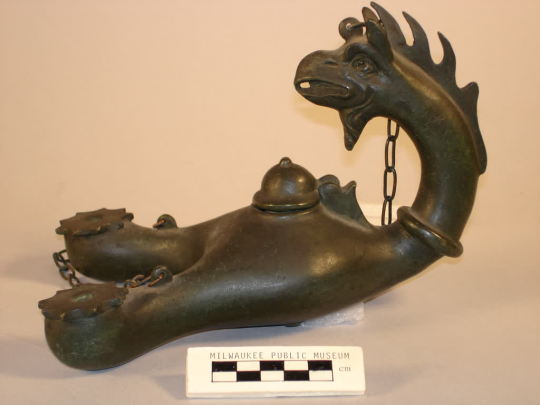
As for beeswax, so far as the podcast is concerned might as well not exist, despite being a by-product of honey, which was THE principal pre-sugar sweetener for centuries when not being made into all that mead whose existence, production and quaffing nobody questions.
Oh yeah, and then there was the amazed discovery (2:40 / 1:25, depending on which you're listening to) that melted beef fat "...smells really nasty, like, ANIMAL nasty,"
Why is this guy surprised? It's part of an animal!
*****
It's the same sort of infotainment ignorance as displayed by this TikTok twit, right up to complaining about the effort involved in preparation of anything because not having powered appliances was so labour-intensive, oh woe. Yes, it was, welcome to any historical period before about 1920. That's where "the daily grind" originates.
However the implication (listen, it's there) that cattle were raised just to provide fat for candles is ludicrous. The fat was a by-product, not a main one, and was often a butcher's side-line, while members of the Chandlers' Guild only worked with superior beeswax.
I don't think you could make candles like these with tallow:
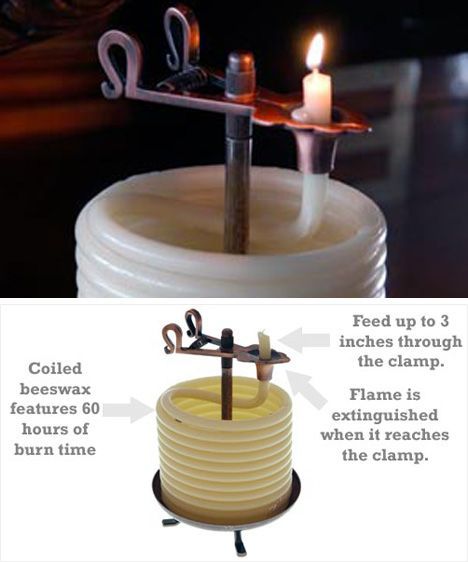
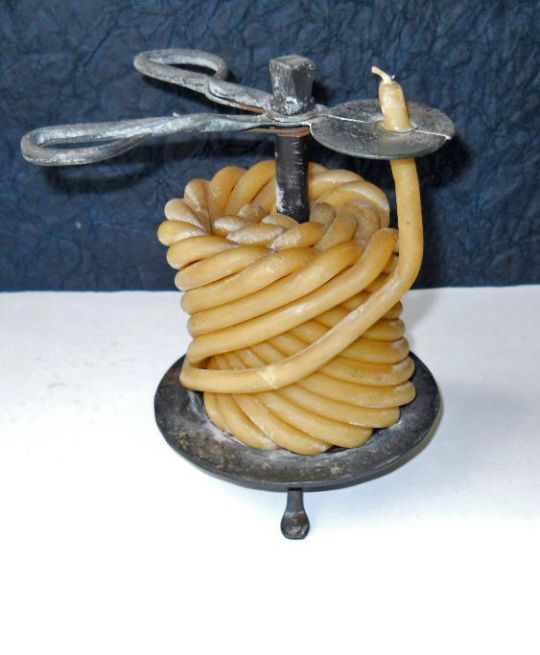
...and you definitely couldn't make one meant to be hand-held.
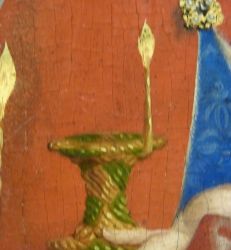
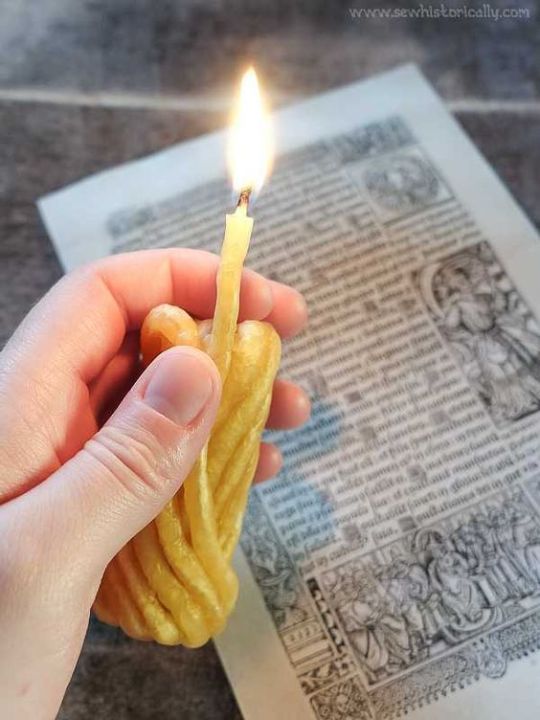
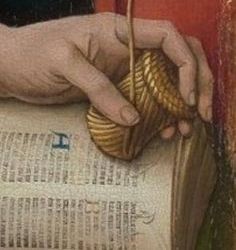
Picture evidence shows, by their clothing, the class of society who bought these, and tallow-greasy fingers would have been a no-no.
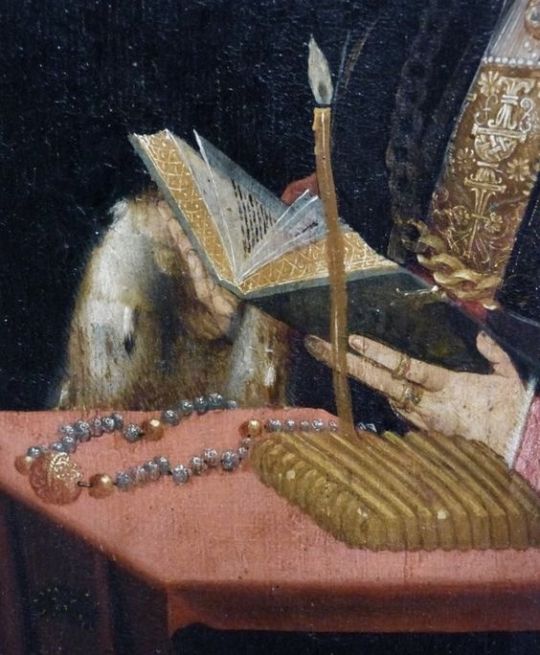
A Chandler didn't make individual candles. By the time that fresh batch is hung up, the first batch away down at the end is cool enough to be dipped again.
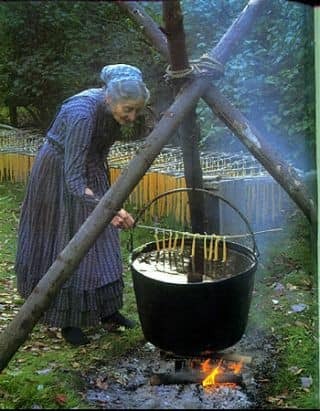
A chandler's shop in a medieval city would look very similar, and often had a horizontal wheel on which to hang each batch of candles, rotating them up and around to cool, then back to the dipping pot. Non-modern people may not have had modern tech or time-and-motion studies, but they weren't stupid.
*****
By contrast, the podcast's disparaging attitude of WEIRD and PRIMITIVE is emphasised by what seems a deliberate avoidance of anything which counters it (examples of that in my own posts) and finally at 11.24 / 9:50 came this:
"Even when you get all the way to the 1700s (...) most people are still subsistence farmers, living in some kind of hut, trying to grow enough food not to starve to death (...) and light? Light still comes from finding stuff that's lying around and just lighting it on fire."
Some kind of hut...
Stuff that's lying around...
After making such a declaration, I'm surprised - since they'd been implying it for half the podcast - someone didn't just go ahead and announce that "there's some lovely filth down here..."

That's when I stopped listening.
Enough is enough, and I'd had it.
*****
ETA:
cc: @asmuchasidliketo :->
Here's a photo of what purports to be a Petrel (not petrol, that's something else) Candle, held in the Pitt-Rivers Museum, Oxford. It's mentioned in that scholarly article I linked above.

Just as "one swallow doesn't make a summer", so one - and only one - known example of this, which may have been a fake-up to spoof the Southerners, doesn't prove it was a common or even rare practice.
There's another reason to take this with a big pinch of salt, so maybe Jane Brox was on a low-sodium diet when she wrote her book.
Creatures with a layer of fat or blubber for insulation all have it like any other form of insulation, on the outside, where it does some good. A wick passed through the inside couldn't draw on it for fuel since there's a layer of muscle and another of internal organs for the oil to get through first.
The cropped-off bottle just visible to the left is a far more likely way seabirds became lamp fuel: by rendering out their oil. This oil is from the Northern Fulmar, Fulmaris glaciaris (or glacialis, I've seen both. Same bird regardless).
Incidentally, the Wikipedia article on European Storm Petrel mentions a supernatural connection, that the petrels were the souls of drowned sailors, and killing them is unlucky.
Not just killing them but making them into candles sounds like A Bad Idea, and is yet another reason why, IMO, the candle thing may be a folktale, or a deliberate leg-pull, or...
Let's just say "improbable" and leave it there. :-P
463 notes
·
View notes
Text
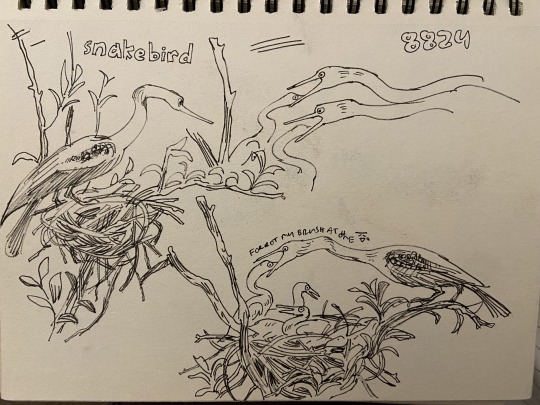

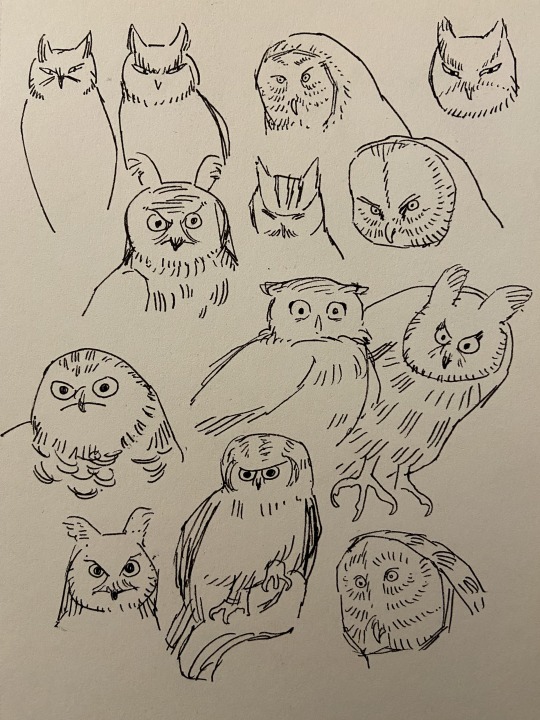
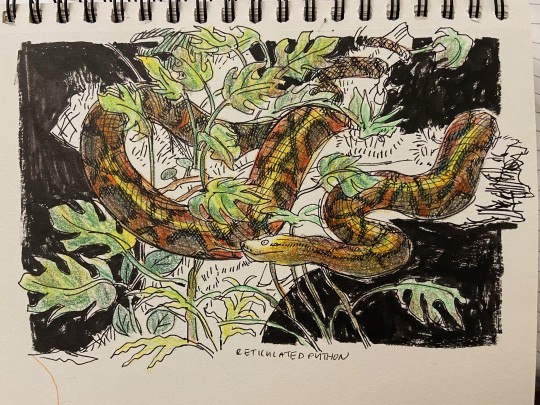
drew some creatures at the amnh :0
#sketchbook stuff#artists on tumblr#went to the butterfly pavilion too#they had an exhibit called opulent ocean and gOSH :'D#basically it was like old science/field drawings(??) of marine life but museum made them#into these huge posters on the wall and they were really gorgeous to see up close oauuauaughhgh#knew I forgot something at homehahhsfs aka my brush and the incorrect charger cord#would've stayed longer but my phone was kinda running out of battery#some of the exhibits are kinda dark so I'm just scribbling away colors/hoping they look fine hAHA#kinda interesting to see them later in normal light#edit: hmm...what if I made a pdf of all the museum/aquarium drawings#edit: also huh I am like...2/3 done with this sketchbook#which is kinda cool becasue I started it in february#also almost done with the birthday sketchbook from last year
1K notes
·
View notes
Text



and that marks the completion of my second Unleashed playthrough!
#me when i say i dont want to fight dark gaia ever again and then i do it anyway#probably gonna do it if they ever release official remaster too#still staying my by statement that while xbox version is pretties the ps2 version was easier to play through. even more firmly now in fact#great experience to see it all in hd though#sonic#sonic the hedgehog#sonic the werehog#amy rose#miles tails prower#chip the light gaia
490 notes
·
View notes
Photo


I was inspired from on high (Patreon)
#DDoodles#Shitpost#Dan and Phil#UT#Handplates#Gaster#What a tag combo lol#POV: You insulted the Dreemurrs#The G in LGBT stands for Gaster now you know#AroAce skelefam supremacy lol - the whole skeleton family tree are aroace we love them for that <3#Someday I'll write that essay proper about why all my faves are aro/ace to some capacity lol#For now it's goofs and gaffs#Literally As Soon as they both played these cards - I am so thankful to Phil for making an ace joke to the + honestly#Nothing drives me up the wall more than ''A is for Ally'' like no tf it is not thank you <3 If you must you can have a second A but come on#So the + ace joke primo excellent thank you#Dan was immensely correct for his addition tho - made it too perfect I immediately saw Gaster's grumpy face about it#I see him everywhere............... (lol)#Extremely excellent and correct choices leading to an inspiration this is why I watch them religiously#Definitely no other reasons like they're a bright spot in this dark world always deriving joy and light#Gaster also fits that bill huh - too many beautiful lads out there really thank you <3#Alright enough silliness for now#Love yous#<Oh you can barely tell that I was tipsy while writing these tags lol
652 notes
·
View notes
Text
hey

HEY

hey @comicaurora I just wanna talk
#something something you can't see in the dark but the light will blind you too#i'm obsessed with these two
766 notes
·
View notes
Text

Spreading my Demiromantic Jon agenda one doodle at a time.
He’s thinking about Martin…
#TMA#the magnus archives#Jonathan Sims#the archivist#pipart#I’m demi and I like when my favourite characters are too!#sorry for the background being so dark. migraine. the light burns
932 notes
·
View notes
Text

sacrifice
day 3 souyo week '24 @souyoweek2020
#persona 4#yosuke hanamura#yosuke#souyo#spoilers#for true ending :3#hmm i think this piece might be too dark...light sensitivity messing up stuff again grrrr#already broke the don't draw just yosuke lol#used refs for the hands
1K notes
·
View notes